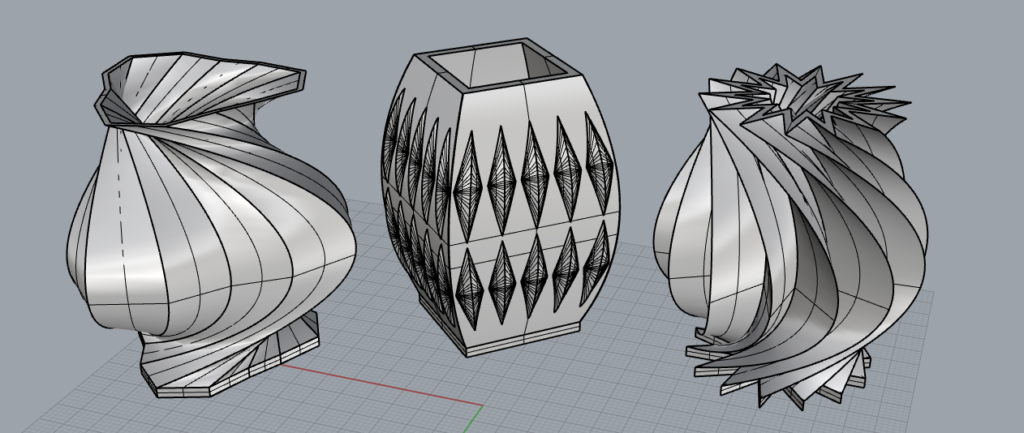
These were the 3 vessels I originally wanted to print, but when rendering 2 of them, they didn’t come out as planned and so I had to go to an alternative route.
My trial Vessel
For this first vessel, I used the same code used in class and just tweaked the sliders to get a shape and form I liked. After I got the shape I wanted I quickly got the .stl file and then continued to mess with the slider, I forgot to save the baked form and wasn’t able to preserve the same shape in Rhyno.


For this vessel, I’m not sure why my settings for layer height were set to 10mm instead of 20mm, so it took a total of 5 hours instead of 3.
Second Vessel
For My second design, I wanted to make a regular vessel with a pattern on the outside. So I created a surface and placed a stretched star on it, made copies of it to replicate a pattern. I then made the star into a “popping-out” “-like texture. I then used the “Flow along surface” and pasted that design on the sides of my vessel and got the picture you see below.




However, as I created the .stl file, the vessel didn’t quite go as planned, for some reason the surface detached itself from the vessel. Also, the inside of the vessel was being filled.
Here is the reference video I used to create that pattern: https://youtu.be/CmOnbjqUWeM?si=2nWKFY8osBmRIfQC
I also believe it’s because the vessel was created with code, and the pattern was done manually, there might’ve been some conflict.
Second Vessel: Attempt 2


Because of that Issue, I had to discard that idea and stick with the code.
The code I used is a slightly modified version of the one in class. Within a loop, it calculates the X and Y coordinates of each point based on the angle around a circle. What makes this pattern interesting is the “undulation” effect added to the radius. It introduces a sinusoidal variation (undulation) in the radius of each point, causing the lines to go in and out, creating a star-like appearance. Which inspired the next vessel.
Vessel 3

I really love the way this one came out. I was really worried about if the outer curves were going to be too thin.

However, as I got the STL file ready. I noticed that there were holes in it. I’m pretty sure as the printer gets to that layer, there are going to be issues. Now for this one, it said it was going to take 9 hours. I was very sad because I couldn’t print this vessel. I knew it had to do with the curvature and the facets, As I reduced both, the holes disappeared but it didn’t come out to my liking, so I discarded this idea as well.
I had consumed most of my time with these discarded pieces and I quickly started running out of time to print them. So I tried my best to do this last piece.


This came out interesting, but what I also didn’t realize is I forgot to reduce the scale when I was messing with it. I ended up printing this at 200%. This one took about 10 hours to print. This may look small in the picture, but it is huge! The top of it did not come out, it fell off so I had to stop the printing.
Your designs turned out wonderful. I especially like the star shaped vase. I was trying to manipulate my vessels to do some similar things but was unable to get anywhere. It is also impressive that some of the centers look to have been moved to make the vessel move in a vertical motion. Great job and great printing.
Thank You! I put a lot of time trying to get that start shape but as you already know I wasn’t able to.
Hi Nathaniel, Your designs are really cool, I like the attempt at adding the popping out pieces to the vessel too bad they didn’t work out. I also did a star shaped vessel its weird how thin your spikes came out compared to mine. I’d be curious to see what your code looked like to give such different results.
Thanks! I really wish I was able to print the popping out pieces as well. I watched a video, and trying to replicate that video took some time too. The spiked came out thin because I think I had a large amount of facets as well as having it spin quite a bit as well.
Hey Nathanial! Your journey in parametric vessel design demonstrates the challenges and innovations inherent in the process. While the first vessel highlights the value of making code adjustments, the second vessel’s challenges emphasize the complexities of merging manual and coded designs. The star inspired third vessel and the unintended scale of the final piece both underline the unpredictable nature of design. Your adaptability and persistence throughout this project are commendable.
Best,
Daniel
Thank you so much for your comment! Since this was my first time doing this, I’ve learn quite a bit!